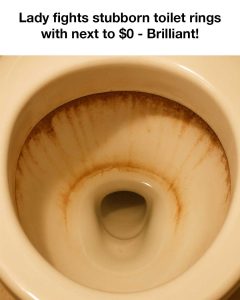Toilet rings are one of those pesky problems that can make an otherwise clean bathroom feel unsanitary and neglected. Despite regular cleaning, these stubborn stains often linger, leaving homeowners frustrated and searching for better solutions. The root of the problem often lies in hard water, which is rich in minerals like calcium and magnesium. As this mineral-laden water evaporates in the toilet bowl, it leaves behind deposits that eventually form a ring around the waterline. Add to that the damp environment, which encourages bacteria and mold growth, and you have the perfect conditions for a persistent toilet ring. While many commercial cleaners advertise their ability to eliminate these stains, they often come with a hefty price tag and harsh chemical ingredients. Thankfully, there are simple, low-cost, and eco-friendly alternatives that are just as effective, if not more so.

Understanding the reason toilet rings form is the first step in finding the right solution. When toilet water sits still, it begins to evaporate, leaving minerals to cling to the porcelain surface. Over time, this builds up into a visible ring. The frequency of toilet use, water hardness, and how often the toilet is cleaned all influence how quickly and severely these rings appear. By recognizing what causes these stains, homeowners can better prevent them in the first place and know how to get rid of them when they inevitably appear.
For budget-conscious homeowners, the good news is that effective cleaning doesn’t have to mean spending money on chemical-laden products. Many everyday household items double as powerful cleaning tools when used the right way. Items like vinegar, baking soda, borax, and even some unexpected pantry staples like drink mixes can be surprisingly effective at breaking down toilet rings. With these simple products, you can keep your toilet looking spotless without spending much money or exposing your family to potentially harmful chemicals.
Some of the most viral and well-loved cleaning tips involve items you probably already have in your kitchen. One classic method involves vinegar and baking soda. Pouring a cup of vinegar into the toilet bowl and adding a good sprinkle of baking soda causes a fizzy chemical reaction. Let it sit for at least 30 minutes before scrubbing, and the result is often a noticeably cleaner toilet. Another surprising option is lemon-flavored Kool-Aid. This drink mix contains citric acid, which is great for dissolving mineral deposits. Just pour a packet into the bowl at night and scrub in the morning. You’ll not only get a cleaner toilet, but a nice citrus scent too.
Borax, a mineral-based cleaning agent, can be mixed with a bit of water to form a paste. Apply it directly to the toilet ring and let it sit for about 20 minutes before scrubbing. It works especially well on tougher stains. A pumice stone, when used carefully, can physically scrub away buildup. Always wet the stone first and use a gentle touch to avoid scratching the porcelain. Denture cleaning tablets offer a convenient and low-effort option. Drop a couple into the bowl, let them fizz for 30 minutes, and then scrub. Even Coca-Cola, thanks to its phosphoric acid content, can break down mineral buildup—just pour a can into the bowl, wait an hour, and scrub.
Among these, lemon Kool-Aid stands out as an unusual yet powerful cleaner. Its citric acid content targets the very minerals responsible for toilet rings. When the powder dissolves in water, the acid begins breaking down the deposits almost immediately. It’s a natural cleaner, affordable, and pleasantly scented, making it a favorite among people who enjoy do-it-yourself cleaning hacks. Its surprising effectiveness has even made it a popular cleaning tip shared across social media platforms.
Each of these cleaning methods relies on a specific chemical or physical action to get the job done. Vinegar, which is acetic acid, reacts with the baking soda to form carbonic acid—effective for loosening mineral stains. Borax is a gentle abrasive and also works as a disinfectant. Pumice stones scrape off tough buildup without damaging the porcelain when used properly. Denture tablets contain ingredients that produce a bubbling reaction, helping to lift stains. Coca-Cola’s phosphoric acid breaks down the minerals in much the same way as more traditional cleaning agents. By understanding how each method works, you can choose the one that best fits your situation.
Applying these methods is simple and doesn’t require any special tools or skills. For vinegar and baking soda, start by flushing the toilet to lower the water level. Add the vinegar, then the baking soda, let it sit, scrub, and flush again. With lemon Kool-Aid, just pour the packet in before bed, let it sit overnight, scrub in the morning, and flush. For a borax paste, mix the borax with water, apply it to the stain, let it sit for 20 minutes, then scrub and flush. If you’re using a pumice stone, wet it thoroughly, gently scrub the ring, and flush. Drop-in methods like denture tablets or Coca-Cola just require a waiting period followed by scrubbing and flushing.
Cost-wise, all these methods are affordable, but their effectiveness can vary depending on the severity of the stains. Vinegar and baking soda are among the most effective for moderate buildup and cost only pennies per use. Lemon Kool-Aid works best on lighter stains and adds a fresh scent. Borax handles tougher stains well but may require more elbow grease. Pumice stones are great for thick buildup but must be used with care. Denture tablets and Coca-Cola are the most convenient but may not be strong enough for the worst rings. Overall, vinegar and baking soda offer the best combination of affordability, ease, and power.
It’s also important to take basic safety measures. Always wear gloves to protect your hands, and never mix different cleaning products, as this can create harmful chemical reactions. Use a light touch with pumice stones to avoid scratches. All of these methods are better for the environment than chemical-based cleaners, helping to reduce the amount of toxic substances that make their way into the water system.
In conclusion, toilet rings may be annoying, but they’re far from impossible to deal with. Whether you’re looking for a quick fix or a deeper clean, there’s a method that will suit your needs. Vinegar and baking soda are ideal for most stains, while lemon Kool-Aid offers a fragrant, effective alternative. For heavier buildup, borax or a pumice stone may be necessary. By knowing the root causes of toilet rings and using these simple, affordable solutions, you can keep your bathroom looking fresh and clean without much hassle or expense.





